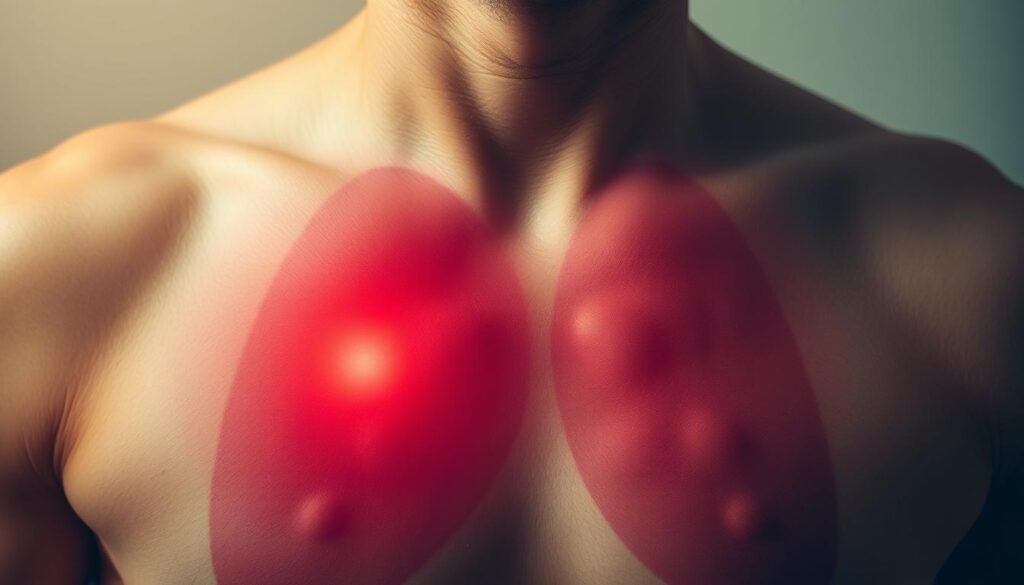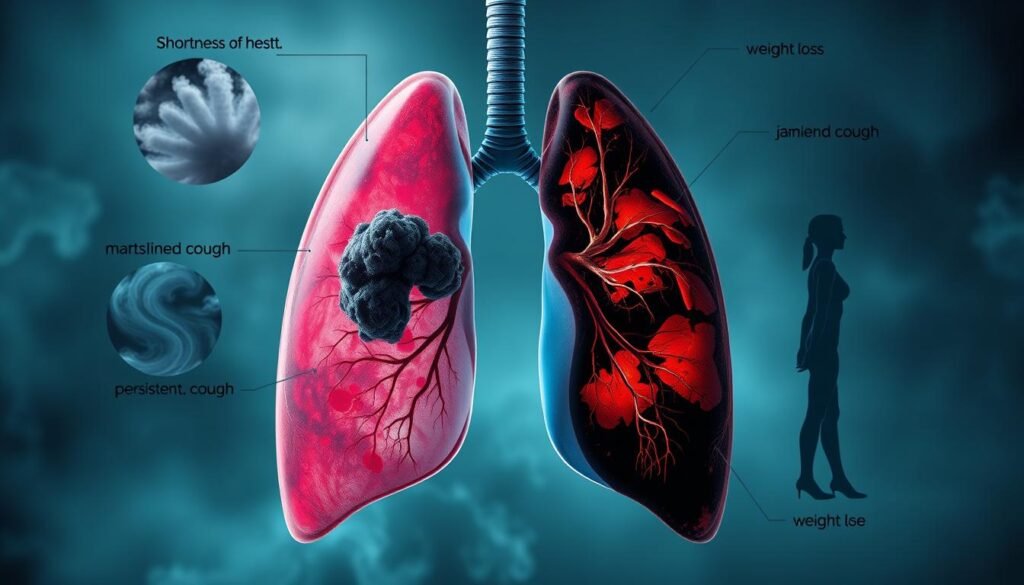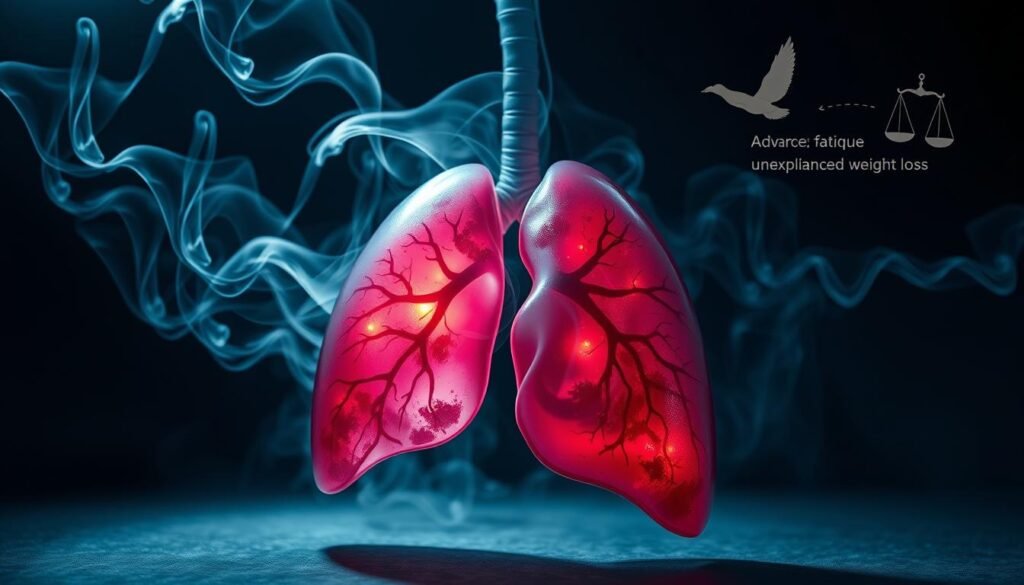Lung cancer is the top cancer killer worldwide, causing over 1.8 million deaths each year. Knowing the signs of this deadly disease, particularly advanced lung cancer, is key for early help. It can lead to better health outcomes. Advanced lung cancer shows in many forms, so it’s important for people and their loved ones to know these signs.
Symptoms can look like those of other conditions, so one shouldn’t ignore ongoing signs that might point to lung cancer spreading. Recognizing these signs early can change a patient’s care plan greatly. It helps with making choices about treatment and care. This article will look at the symptoms of advanced lung cancer. We aim to provide information that might help with early spotting and managing the disease.
Key Takeaways
- Advanced lung cancer symptoms significantly impact treatment options and patient outcomes.
- Being aware of late stage lung cancer signs can facilitate early medical intervention.
- Metastatic lung cancer symptoms may affect various systems in the body.
- Not all symptoms necessarily indicate lung cancer, emphasizing the importance of consultation.
- Early detection can lead to a more effective management strategy for lung cancer.
Introduction to Lung Cancer and Its Impact
Lung cancer is the top cause of cancer deaths worldwide, with 1.8 million deaths in 2020. This equals about 18% of all cancer deaths. Smoking is the biggest risk for lung cancer, causing around 85% of cases. This fact shows why it’s crucial to teach people about lung cancer causes and how to prevent it.
The effect of lung cancer goes beyond the person. It impacts families and entire communities. Often, lung cancer doesn’t show symptoms until it’s very advanced. This tells us to always pay attention to our lung health. Factors from the environment and our genes also play a part. Even non-smokers can get lung cancer, which stresses the need to deal with environmental dangers.
Screening those at high risk helps find the disease early. This can greatly improve chances of survival. It’s also key to know the different types of lung cancer for treatment. Most cases are Non-small cell lung cancer (NSCLC), but there’s also small cell carcinoma (SCLC). Knowing the difference is crucial for caring for patients. Learning about lung cancer statistics is essential for creating better prevention and treatment methods.
| Lung Cancer Type | Prevalence | Growth Rate |
|---|---|---|
| Non-Small Cell Lung Cancer (NSCLC) | 80% – 85% | Slower |
| Small Cell Lung Cancer (SCLC) | 10% – 15% | Faster |
| Lung Carcinoid Tumors | Less than 5% | Slow |
By knowing the facts and causes of lung cancer, we can better back actions for its prevention, early finding, and treatment. Realizing how serious this disease is, it’s our shared duty to tackle it together.
Understanding the Types of Lung Cancer
Lung cancer is split into different kinds, mainly non-small cell lung cancer (NSCLC) and small cell lung cancer (SCLC). NSCLC is the most common, making up about 85% of cases. It includes types like adenocarcinoma, squamous cell carcinoma, and large cell carcinoma.
Adenocarcinoma takes the top spot as the most common lung cancer in the U.S. It counts for around 40% of NSCLC cases. This kind usually forms in the outer parts of the lungs and is more common among non-smokers.
Small cell lung cancer, on the other hand, is mostly seen in smokers. It makes up about 15% of lung cancer cases. Known for speeding quickly, catching and treating it early is vital. Chemotherapy is the go-to treatment, especially when it’s spread far.
Less common forms of lung cancer exist, like carcinoid tumors and mesothelioma. Mesothelioma is about 5% of cases, often due to asbestos. Regarding lung carcinoid tumors, 90% are typical carcinoids. They tend to grow slowly and spread less.
Common Signs of Advanced Lung Cancer Symptoms
Knowing the signs of advanced lung cancer is key. It helps to catch the disease early. This leads to better treatment chances.
A Persistent Cough
If you’ve had a cough for over eight weeks, pay attention. Such a cough could get worse and bring breathing troubles. See a doctor to find out what’s causing it.
Coughing Up Blood
Seeing blood in your cough is alarming. It’s a sign you need to see a doctor quickly. Watching for blood in saliva or phlegm is important.
Chest Pain and Discomfort
Chest pain that gets worse when you breathe deeply or laugh could mean lung cancer. This pain can feel dull or sharp. Don’t ignore ongoing chest pain.

Want to learn more about lung cancer symptoms? Check out the American Cancer Society and the National Cancer Institute.
Additional Late Stage Lung Cancer Signs
Lung cancer shows more symptoms as it gets worse. Noticing these late stage signs helps with quick help and better care for patients.
Hoarseness and Voice Changes
Many facing advanced lung cancer get hoarse. Tumors near nerves can make one’s voice sound different. When the voice changes, it might mean the nerves are affected, requiring more checks.
Loss of Appetite and Weight Loss
People with late stage lung cancer often eat less. This leads to weight loss that’s hard to miss. This loss isn’t just from eating less. It can also happen because of cancer cachexia, where the body loses muscle and changes how it uses calories. Watching for these signs is vital since losing weight affects health and treatment choice.
Shortness of Breath and Wheezing
Feeling out of breath is common in late lung cancer stages. Wheezing and trouble catching breath can happen when airways are blocked or if fluid builds up. These symptoms can really limit day-to-day life. They need fast attention to ease the discomfort and help the person.
| Symptom | Description | Possible Causes |
|---|---|---|
| Hoarseness | Change in voice quality | Nerve involvement from the tumor |
| Weight Loss | Significant decrease in body weight | Loss of appetite and cancer cachexia |
| Shortness of Breath | Difficulty in breathing | Airway obstruction or fluid accumulation |
Symptoms Associated with Metastatic Lung Cancer
Metastatic lung cancer marks a critical phase where cancer spreads to other body parts. It’s vital to know the symptoms for early care. Main symptoms include serious bone pain and changes in the nervous system.
Bone Pain
Intense bone pain is common in patients with this condition. It’s often felt in the back and hips. This pain occurs when cancer reaches the bones, disrupting daily life. To manage this pain, there are treatments and medicines that help ease the discomfort.
Nervous System Changes
Changes in the nervous system are also significant. Symptoms like headaches, confusion, weakness, and balance problems can appear. These signs suggest that the cancer might have reached the brain. Early recognition of these symptoms is important for getting the right treatment and support.

Specific Symptoms of Advanced Non-Small Cell Lung Cancer Symptoms
Advanced non-small cell lung cancer showcases troubling signs. A chronic cough is the most common symptom, with about 65% of patients affected. Nearly 33% find blood in their sputum, a serious warning sign. Also, chest pain is reported by 17.9% of people at the start.
The symptoms vary more in advanced stages. About 8.3% of patients lose weight, showing the cancer’s impact. Around 5.9% struggle with mobility due to pain from metastases. These symptoms highlight the disease’s progression, calling for careful management.
Patients with squamous cell carcinoma often have a chronic cough and bloody sputum. Conversely, those with non-squamous types usually report pain from metastases and swollen neck lymph nodes. By stage IV, many suffer from increased chest pain, breathlessness, and fatigue. This significantly lowers their life quality.
It’s vital to recognize these symptoms early. Treatments like chemotherapy, immunotherapy, and targeted therapies can make a difference. For further details on lung cancer, check out the Mayo Clinic here.

| Symptom | Prevalence (%) |
|---|---|
| Chronic Cough | 65.0 |
| Sputum with Blood | 33.0 |
| Chest Pain | 17.9 |
| Weight Loss | 8.3 |
| Metastases Pain | 5.9 |
Advanced Small Cell Lung Cancer Symptoms
Advanced small cell lung cancer (SCLC) progresses quickly, causing distressing symptoms. Patients face tough challenges as the disease moves forward. Spotting these signs early helps get the right medical care, bettering patient lives.
Signs of Rapid Progression
Those with advanced SCLC may show several urgent symptoms. Below are the most common rapid progression signs:
- Severe Fatigue: Persistent tiredness that affects daily activities.
- Weight Loss: Unintentional and significant decrease in body weight.
- Respiratory Distress: Notable difficulty in breathing, often exacerbated during physical exertion.
- Difficulty Swallowing: A growing challenge when consuming food or liquids.
- Dizziness or Severe Headaches: Symptoms caused by metastasis affecting the brain.
- Swelling in the Neck or Face: Potentially due to pressure from tumors or affected lymph nodes.
Identifying these symptoms is crucial for healthcare providers to offer the right treatment. Knowing these signs helps quickly address patient needs as the condition worsens.
| Symptom | Description |
|---|---|
| Severe Fatigue | A state of chronic exhaustion that hinders everyday tasks. |
| Weight Loss | Noticeable decrease in body weight without dieting. |
| Respiratory Distress | Increased difficulty in breathing, especially during activities. |
| Difficulty Swallowing | Challenges with consuming solid or liquid foods. |
| Dizziness/Severe Headaches | Feeling lightheaded or significant head pain due to cancer spread. |
| Swelling in Neck/Face | Visible enlargement possibly from lymph node involvement. |
Recognizing End Stage Lung Cancer Symptoms
As lung cancer moves to its final stages, it’s vital to know the symptoms. This knowledge aids in giving the right care and support. Patients may show signs that their disease has progressed, including noticeable health changes.
Swelling of Lymph Nodes
Lymph node swelling is a key sign, often around the neck or collarbone. This happens when cancer spreads, causing inflammation. Such swelling can be tender and might affect daily life.
Jaundice Symptoms
Jaundice is another serious symptom, making the skin and eyes yellow. It usually means the cancer has reached the liver. This situation calls for urgent care and possibly more comfort-focused treatment.
Knowing symptoms like lymph node swelling and jaundice is crucial for care planning. Recognizing when to get help makes a big difference in support levels during hard times. For more details on managing late-stage lung cancer, visit this resource.
Importance of Seeking Timely Medical Care
Getting medical help quickly is key to dealing with lung cancer well. Spotting symptoms early and acting fast can greatly change the outcome. Knowing the signs is crucial for both patients and their families.
Lung cancer is the top cause of cancer deaths in the United States. In 2014, around 224,210 people were diagnosed and 159,260 died from it. The chances of surviving drop a lot at Stage III and IV, to 5% and 1%.
It’s very important to see a doctor as soon as you notice something might be wrong. Stigma can make people wait too long to get help. By encouraging quick visits to the doctor, we can find and treat cancer sooner. Teaching people about lung cancer signs can reduce stigma and push for earlier doctor visits.
Early treatments like surgery, radiation, and chemotherapy work better. Staying on top of treatment and knowing how the disease is progressing is key to living longer. Here is a table showing how early action helps more than waiting:
| Timing of Treatment | Survival Rate | Available Treatments | Patient Outcomes |
|---|---|---|---|
| Early Intervention | 10% – 20% | Surgery, Chemotherapy | Improved Prognosis |
| Delayed Treatment | 1% – 5% | Limited Options | Poorer Outlook |
Seeking medical care quickly can change the course of lung cancer treatment. Telling people to get regular check-ups and know the symptoms can lead to quicker access to vital health services.
Conclusion
Knowing the signs of advanced lung cancer is key to better outcomes and lung health. Early detection leads to better treatment options. This can make a big difference in patients’ lives, even as the disease advances.
It’s vital to talk openly about symptoms and urge those at risk to get medical help soon. This way, we might save lives and support those facing lung cancer. Teaching about lung cancer and the value of regular checks can lead to earlier discovery and treatment.
Working together to understand lung cancer can lower stigma and encourage healthier lives. By focusing on lung health, we benefit everyone and work towards a future with less lung cancer. This comes from taking action early and making informed health decisions.